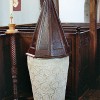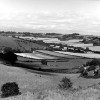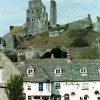This small village five miles south east of Dorchester has a Manor House, Mill and Mill House, a few thatched cottages and a Church to remind us of its place in history. Furthermore, for a period during World War II airmen of the Royal Air Force flew missions from a hastily built aerodrome here on an area that is now a quarry.
After the conquest the manor was granted to a Norman, Geoffrey de Warmwell; it later passed to the Newburghs and in the early 17th century came into the possession of the Trenchhard family. Sir Thomas Trenchard was the first in the family to hold it. Sir George Trenchard settled the manor on his son John and it passed to John Sadler through marriage to Jane, Sir John Trenchard’s daughter. The Richards family took possession of the Manor and Warmwell House in 1687, then held it for three generations until in 1806 William Richards sold the Warmwell property and the new owner’s daughter married Capt. Augustus Foster. The estate remained in the hands of the Foster family until 1935.
A Commercial Day Book and a Diary belonging to John Richards have survived from the 18th century and shine a light on business and social life at the time; we will be taking a closer look at these in another article.
John Sadler was a prominent London lawyer who held several offices during the Commonwealth period and for a time was Oliver Cromwell’s personal secretary. He was elected Town Clerk of London on 3rd of July 1649, an office he held until the 18th of September 1660, when he was declared incapable of office. He was nominated as MP for Cambridgeshire in 1653 and in 1659 he was MP for Yarmouth in the Isle of Wight. He was fluent in several Oriental languages.
On the Restoration he lost most of his properties and retired to Warmwell in 1662 in poor mental and physical health. On his deathbed, where he was attended by his wife, a local church minister and his servant, he foretold three major future events: the Plague, The Great Fire of London and the Monmouth Rebellion.
The Parish of Warmwell consists of almost 1,700 acres in a rectangular plan, with the village near the well-wooded middle area. Nearby is the source of a small brook which flows northwards to join a tributary of the River Frome.
The Parish Church of The Holy Trinity stands at the south end of the village. The Nave was built in the 13th century and the West Tower was built (or possibly rebuilt) in the 17th century. The church was restored in 1851 and in 1881 a new chancel was built. Inside the church are monuments to members of the Richards family: William Richards 1833; William Richards 1803 and Margaret (Clavell) his wife 1817; Susanna and Edward, children of William and Margaret Richards 1803. In the churchyard a table-tomb to Henry Vie 1691 and there is an area looked after by the War Graves Commission, where there are memorials to those lost during World War II, mostly airmen but there are some to prisoners of war.
The present Warmwell House was built in the early 17th century, probably by Sir John Trenchard, who inherited the manor in 1618. The south-east side of the house is thought to include the remains of an earlier building.
Warmwell Mill dates from the late 18th century or early 19th century. In the mid-19th century the miller’s house was added. There are other listed buildings in the village: The Stables and the Lodge House which belong to the estate and Rose Cottages, a pair of estate cottages standing by the side of the road through the small village, which gets its name from a well of tepid water that is the source of the brook..



